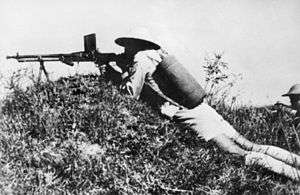Battle of Changsha (1941–42)
The third Battle of Changsha (24 December 1941 – 15 January 1942) was the first major offensive in China by Imperial Japanese forces following the Japanese attack on the Western Allies.
| Battle of Changsha (1942) | |||||||
|---|---|---|---|---|---|---|---|
| Part of the Second Sino-Japanese War and World War II | |||||||
 A Chinese soldier mounts his ZB vz. 26 light machine gun at Changsha, January 1942. | |||||||
| |||||||
| Belligerents | |||||||
|
|
| ||||||
| Commanders and leaders | |||||||
|
|
| ||||||
| Units involved | |||||||
|
9 Armies - 20+ Divisions |
| ||||||
| Strength | |||||||
| 300,000 soldiers |
120,000 soldiers[1] 600 pieces of artillery[1] 200 aircraft[1] | ||||||
| Casualties and losses | |||||||
|
Japanese claim: 28,612 killed 1,065 captured[2] |
Japanese claim: 33,941 killed 23,003 wounded [5] | ||||||
The offensive was originally intended to prevent Chinese forces from reinforcing the British Commonwealth forces engaged in Hong Kong. Gen. Anami was furious about Chinese claims of his defeat in his September-October 1941 Changsha Offensive. The original intent was to mount a thrust with his army to support the Twenty Third Army's attack on Hong Kong. He was supposed to maneuver his army from the south of Hankou, east of the Hankou-Canton Railway about 19 miles and reach the Miluo River. General Anami disobeyed orders from Imperial Headquarters and maneuvered his army 22 miles for Changsha.[6]
Anami's main forces consisted of 27 infantry battalions, 10 artillery battalions, and one battery.[6]
Attack
The Japanese commenced combat operations on 24 December, with the 6th and 40th Divisions leading the way. Japanese forces initially cut through Chinese defenders. By 29 December, believed that the city was "inadequately defended", Anami elected to capture the city. He committed his 3rd and 6th Divisions and his forces were surprised to met fierce opposition. His 3rd Division penetrated the southeastern side of the city but made no further movements. On 4 January, the Eleventh Army occupied "all the important points of the city", but they were in danger of being encircled by counterattacking Chinese.[6]
Result
With the prospects of becoming encircled, the Eleventh Army ordered a withdrawal on 4 January. Units were also low on munitions and rations. Withdrawing forces fended off attack by nine armies and over 20 Chinese divisions. Further complicating matters, this was done while protecting rear service units and wounded. Some Japanese units, like the 200 man detachment from the 9th Independent Mixed Brigade were almost completely destroy (only one survivor).[6]
The offensive resulted in failure for the Japanese, as Chinese forces were able to lure them into a trap and encircle them. After suffering heavy casualties, Japanese forces were forced to carry out a general retreat.[1]
References
- Hsiung, James Chieh; Levine, Steven I. China's Bitter Victory: The War with Japan, 1937–1945, p. 158
- Senshi Shoso, "Hong Kong and Changsha" pp. 665
- Japanese Monograph No. 71, Army Operations in China pp. 76.
- https://www.youtube.com/watch?time_continue=183&v=MxAUa8y9mV8
- Frank, Richard B., "Tower of Skulls: A History of the Asia-Pacific War, Vol 1: July 1937-May 1942 pp. 665
- Frank, Richard B. (2020). Tower of skulls : a history of the Asia-Pacific war, July 1937-May 1942 (First ed.). New York. p. 315. ISBN 978-1-324-00210-9. OCLC 1141201603.